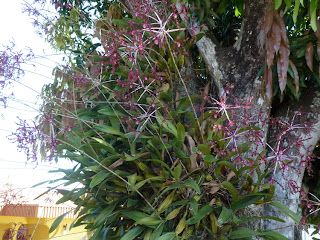Here we are, time for another Spanish/English dinner party with Marcial and Sadie tomorrow night, which means that almost two weeks have past since my last entry here. If I thought that “retirement” meant inactivity, boy, was I wrong! We scratch our heads at times wondering what keeps us so busy. In some ways, our schedule fills up with the luxuries of retirement: time to take long walks, time to correspond with friends, time for elaborate dinner preparations and dinner parties, and for Layne, that long-delayed novel is taking shape. Indeed, the man has over 150,000 words written and, he says, only a couple more chapters to go. Then we’ll have to learn what all is involved in self-publishing on the Internet.
 |
| The Aquacate Tree |
But the dry season (or “high” season, referring to hotel rates) is definitely here. Suddenly the landscape has changed from lush greens everywhere to patches of dry, golden brown grasses on the hillsides. It’s somewhat reminiscent of those “golden hills” of California, but that would be in June, not in January! Our aquacate (avocado) tree is absolutely weighted down with blossoms and hundreds of tiny avocados. We can hardly wait till they ripen and we can enjoy guacamole every day.
 |
| Tiny avocados soon to be ripe! |
Another plant in blossom right now is the orchid, my favorite. Waiting for the bus a few days ago, I noticed that the big cluster of orchid plants attached to the mango tree had suddenly burst into bloom. And what odd blooms they were! Orchids are known for the enormous diversity of flowers they produce and this was certainly one I had never seen before: curly, delicate purple petals around a pink-throated central core on a long spike coming out of the leaves. Quite beautiful and so unusual.
 |
| A most unusual Orchid |
 |
| Orchids on the Mango tree |
With the change of seasons, we are learning more about agricultural patterns here. For instance, a couple of weeks ago, we noticed some workers in the cornfield below us, chopping down the dry stalks with, of course, machetes. Just two guys to cut down the entire field! But labor is cheaper here than machinery and requires less maintenance, so to speak, so such heavy work is mostly man-powered.
Another example of labor-intensive work we recently encountered is making charcoal. On a trip back from PriceSmart with our friend Jeanette, we stopped off at a finca (farm) along the road to Santa Eulalia that Marcial had told us about where we could buy organic honey. While there we questioned the mustachioed gentleman in charge about the other products that he had in his large garden and learned that he also grows organic tomatoes, chili dulce (much like a green pepper), hydroponic lettuce and green onions. Part of the mixture in his hydroponic bins, we noticed, was bits of charcoal and since Layne and I had just purchased a small barbeque grill, we asked if he sold charcoal as well. Yes, he said, and proceeded to guide us further back in the garden to where two men were piling logs about 3-4 feet long into a deep gulley they had apparently dug.
 |
| Organic gardener with Chili Dulce |
It seems that they will somehow set the wood on fire and then bury it in dirt so that it smolders without burning, turning the wood into charcoal. Amazing! Whether or not this charcoal would work for our grill, we are yet to determine but it was a fascinating how-to lesson for us Gringos.








We live in Limon and we made our own charcoal last year. During the rainy season lots of trees fall and most are good for charcoal. Beware of Gavilan though it's toxic. We make big burn piles with the thickest of trunks on the inside and burn scrap wood and our corn stalks on the outside. We use it all year long!
ReplyDeleteDo you use the charcoal for cooking and/or hydroponics? I've seen it used in a 50/50 mixture with red lava rock for hydroponic veggie growing. It seems a little light for cooking compared to the compressed briquets in the States, but I imagine it would work well just the same.
Delete